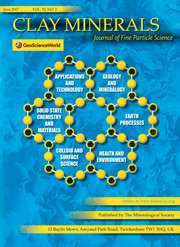Crossref Citations
This article has been cited by the following publications. This list is generated based on data provided by Crossref.
Mackenzie, R.C.
and
Mitchell, B.D.
1966.
Clay mineralogy.
Earth-Science Reviews,
Vol. 2,
Issue. ,
p.
47.
1973.
The Chemistry of Clay Minerals.
Vol. 15,
Issue. ,
p.
189.
Isphording, Wayne C.
1973.
Discussion of the Occurrence and Origin of Sedimentary Palygorskite-Sepiolite Deposits.
Clays and Clay Minerals,
Vol. 21,
Issue. 5,
p.
391.
Farmer, V. C.
and
Palmieri, F.
1975.
Soil Components.
p.
573.
1977.
Miocene of the S.E. United States A Model for Chemical Sedimentation in A Peri-Marine Environment.
Vol. 22,
Issue. ,
p.
227.
Weaver, Charles E.
and
Beck, Kevin C.
1977.
Miocene of the S.E. United States: A model for chemical sedimentation in a peri-marine environment.
Sedimentary Geology,
Vol. 17,
Issue. 1-2,
p.
IX.
1977.
Clays and Clay Minerals in Natural and Synthetic Systems.
Vol. 21,
Issue. ,
p.
187.
1985.
Clay Minerals - A Physico-Chemical Explanation of their Occurrence.
Vol. 40,
Issue. ,
p.
360.
1990.
Clays, Muds, and Shales.
Vol. 44,
Issue. ,
p.
723.
Galan, Emilio
and
Carretero, Ma Isabel
1999.
A New Approach to Compositional Limits for Sepiolite and Palygorskite.
Clays and Clay Minerals,
Vol. 47,
Issue. 4,
p.
399.
Suárez, Mercedes
and
García-Romero, Emilia
2011.
Developments in Palygorskite-Sepiolite Research.
Vol. 3,
Issue. ,
p.
33.
Son, Byeongseo
Hwang, Jinyeon
Lee, Jinhyun
Oh, Jiho
Son, Moon
and
Kim, Kwanghee
2016.
Fe-rich Sepiolite from the Basalt Fault Gouge in the South of Pohang, Korea.
Journal of the mineralogical society of korea,
Vol. 29,
Issue. 1,
p.
11.


